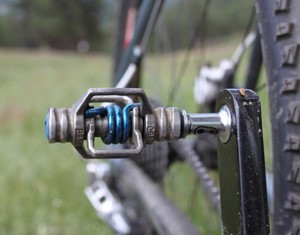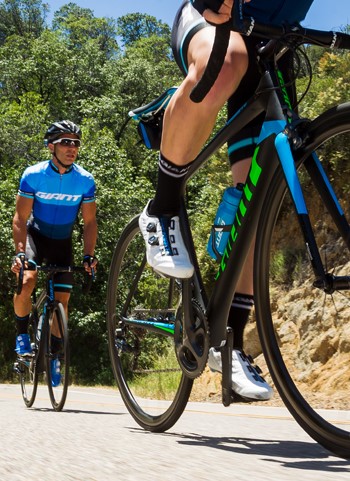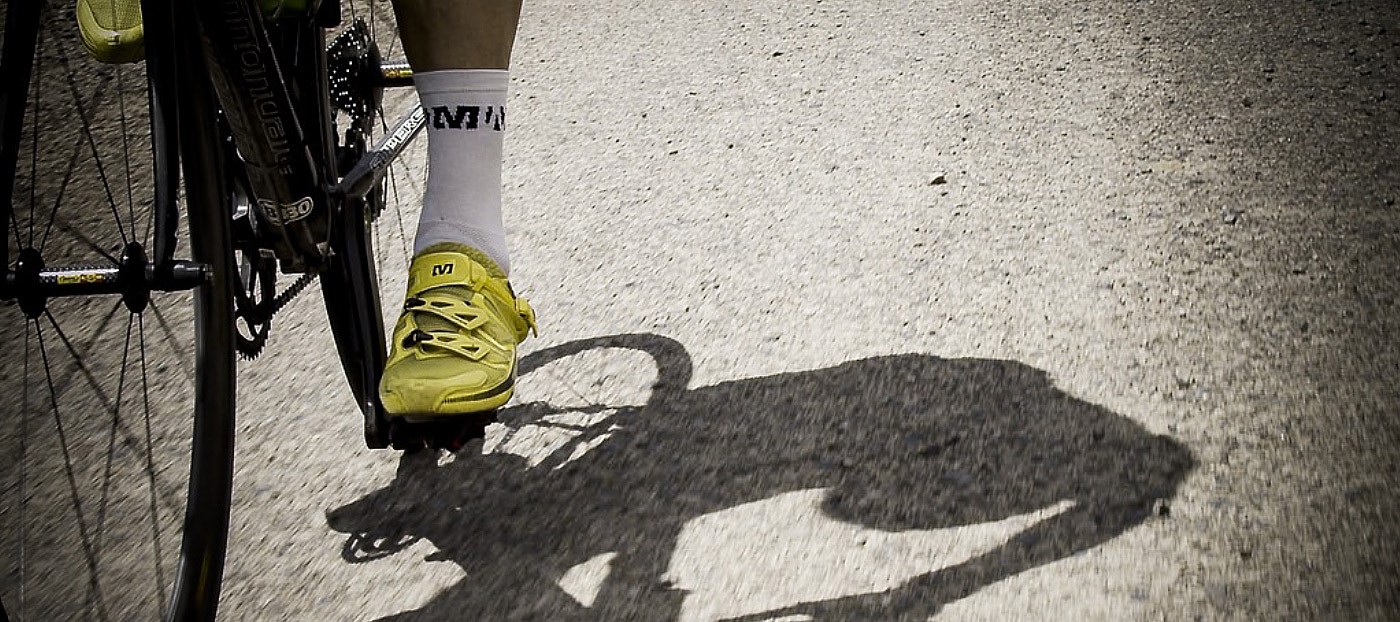Once upon a time, professional cyclists rode on quill pedals, with big toe clips over the front and nylon straps. These were heavy and difficult to get in and out of, so industry boffins had to come up with something new.
Enter, the clipless pedal
Somewhat confusingly, clipless pedals aren’t pedals without clips. Rather, they’re pedals without the big toe clip and strap which go over the top of your shoe. Clipless pedals actually rely on the rider to clip in to them in order to work, but the name seems to have stuck anyway.
Surprisingly, the idea of a clipless pedal isn’t as new as the professional race industry would make it seem. The first patent for a twist-to-unclip pedal was filed in 1895 by Charles Hanson, and even allowed a certain amount of rotational float. Despite his innovation, clipless pedals failed to capture the market and were largely abandoned for a several decades.
When the manual-locking Cinelli M-71 appeared in the early 1970s, interest in clipless pedals was sparked again, although with a tricky lever that needed to be engaged & disengaged by reaching down to the back of the pedal, the M-71 earned the nickname “death pedals” and didn’t catch on either.

Photo: velocompetition.com
The first Look clipless pedals
Various different clipless pedal designed were tried during the 70s and 80s, but it was when the Look PP65 pedal and Delta cleat appeared in 1985 with its ‘step-in, twist-out’ engagement that clipless pedals became a must-have. Modern Look pedals have moved on from the Delta cleat and now use the highly-rated Keo system, which is smaller, lighter and offers better retention & float properties than the previous design.
Look’s three-bolt cleat layout on the PP65 provided excellent rigidity and stability and is still widely in use today. Shimano’s first clipless PD-7401 pedal from 1988 licensed the design from Look, before developing their own SPD (Shimano Pedalling Dynamics) and SPD-R cleat systems, for mountain and road bike usage.
The Shimano SPD pedal

Mountain bike pedals virtually all use the SPD two-bolt cleat pattern (even the innovative Crank Brothers Eggbeater pedals use the two-bolt pattern, albeit with a different cleat design), for roadies there is also the four-bolt Speedplay system (however three-bolt to four-bolt adapters are available).
Speedplay’s ‘lollipop’ road pedals are a little different to others, primarily in that they are double-sided, similar to Shimano’s SPD design. This is achieved by building the clip mechanism into the cleat, rather than the pedal. Effectively, Speedplay pedals clip into your shoes, rather than the other way around.
Speedplay pedals offer a huge range of adjustment too, including rotational and lateral float, as well as the release tension adjustment found on most modern clipless pedals.
Speedplay clipless pedals

Mountain bike pedals virtually all use the SPD two-bolt cleat pattern (even the innovative Crank Brothers Eggbeater pedals use the two-bolt pattern, albeit with a different cleat design), for roadies there is also the four-bolt Speedplay system (however three-bolt to four-bolt adapters are available).
Speedplay’s ‘lollipop’ road pedals are a little different to others, primarily in that they are double-sided, similar to Shimano’s SPD design. This is achieved by building the clip mechanism into the cleat, rather than the pedal. Effectively, Speedplay pedals clip into your shoes, rather than the other way around.
Speedplay pedals offer a huge range of adjustment too, including rotational and lateral float, as well as the release tension adjustment found on most modern clipless pedals.
What are the advantages of clipless pedals?
As already mentioned, clipless pedals offer a significant weight reduction over traditional toe-clip and strap pedals. If you’ve ever suffered from having your foot slip off a pedal, then you will appreciate the added security of being clipped in. Although to an extent you can get that from a broad platform pedal too. For mountain bikers, the real benefits come from the added stability over rough terrain.
 Photo: Jeff – Singletracks.com
Photo: Jeff – Singletracks.comOff-road clipless pedal advantages
Even with wide platform pedals with lots of grippy pins, your foot will typically move around on the pedal over rough ground. On short-travel suspension bikes and hardtails, this becomes a real problem.
Road bike clipless pedal advantages
The more solidly your foot is attached to the pedal, the more efficient the power transfer to the bike will be.
When you’re trying to squeeze every bit of performance out of your body and your bike, being able to secure your feel to the pedals is hugely beneficial. If you imagine a soft rubber block between your foot and the pedal, as you press down, the rubber will compresses and absorb energy which would otherwise be transferred to the bike. For this reason, road bike shoes have incredibly stiff soles as well, which would be uncomfortable to walk around in, but provide the best power transfer to the pedals.
Clipless pedals give you accurate control over the amount of float in your feet
Biomechanically, everyone is a slightly different shape and size. During the pedal stroke, you want your hip, knee and ankle to remain aligned throughout in order to prevent pain or injury. There’s no way to control float in a toeclip or platform pedal, and too much or too little float is a common cause of knee pain with cyclists.

Clipless pedals allow you to put power into the system through the full 360 degrees of crank rotation.
While most of your pedalling effort comes from the effort you put in during the down stroke of the crank cycle, being able to pull up against the pedals at the same time creates another source of power input, helping you to ride faster. Being able to power each leg through a full crank rotation not only opens up the chance for a higher max power output, it allows you to switch between working different muscle groups in your legs, so you can rest one group if it’s feeling fatigued.
Being directly connected to the bike gives you better feedback, and control over how you position yourself.
Going too fast to swerve around that pothole coming up? Want to get up that kerb quickly? You don’t need to learn any fancy bunny-hopping techniques to hop when you’re clipped in – just jump and the bike comes with you! For more advanced users, being able to control the bike in all directions with both your hands and feet can offer significant.

